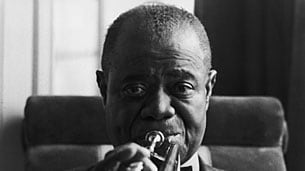Chicago, the thriving cultural capital that produced Louis Armstrong, Al Capone, Michael Jordon and Tina Fey, is finally getting its due.
“They pull a knife, you pull a gun. He sends one of yours to the hospital, you send one of his to the morgue That's the Chicago way!” —David Mamet, The Untouchables
On election night, as the whole world was watching Barack Obama speak in the same park where protestors battled police in 1968, the city by the lake became America’s city on the hill, the epicenter of national politics for a new era.
And why not ? Our town has been has been a pacesetter and a bellwether of American thought, culture and politics for generations—the good, the bad and the ugly.
We gave the world the jazz age and the atomic age.
Click Image to View Gallery

In 1922 Louis Armstrong took up residence here with Joe “King” Oliver. They changed American music forever, begetting more kings: Benny Goodman, the “King of Swing” and Nat “King” Cole. Later came Kanye West and R. Kelly.
Atoms were first smashed in 1942 under a football field at the University of Chicago, a few blocks from the presumptive president’s house.
We gave America its gangster legends—but our guy, Al Capone, was real, not a fictional figment like Vito Corleone or Tony Soprano. Then we produced good-guy legends: Michael Jordan and Oprah.
We have been a crucible for social movements.
May Day became an international labor holiday in honor of the workers who died in1886 when a demonstration for the 8-hour day turned to a bloody police riot in Chicago’s Haymarket. (Most of the world still celebrates it as a labor holiday, although President Eisenhower, in the heyday of the Red Scare, renamed it Law Day.)
There was another bloody clash with police in 1968, when anti-war protestors stormed the Democratic convention and changed Democratic politics for the rest of the century. Students for a Democratic Society was headquartered here. Martin Luther King chose the city for his first northern campaign.
Community organizing was first practiced here by Jane Addams in 1919, and later perfected by Saul Alinsky before inspiring a young man named Obama.
Carl Sandburg called us “Hog butcher for the world,” then Upton Sinclair showed the world its butchershop was “The Jungle.” Nelson Algren and Saul Bellow continued that strain of urban realism in literature, while Mike Royko, the primordial Chicagoan, was maybe the greatest newspaper columnist ever.
Our town has been has been a bellwether of American thought, culture and politics for generations—the good, the bad and the ugly.
Poetry Magazine was founded here and published T.S. Eliot’s “Love Song of J. Alfred Prufrock.” From just past the city limits came Ernest Hemingway to purify the American language and create another heroic legend. What David Mamet later did for the language some might not consider purification.
But don’t get the idea we’re too literary: Playboy magazine was founded here, too. The movies actually began here, as did modern television with Dave Garroway, Studs Terkel and Burr Tillstrom.
A New Yorker dubbed Chicago the Second City, then some improvising young talent took the name and turned us into the first city of comedy, while actors at Steppenwolf and the Goodman Theatre did the same for drama. The Chicago diaspora dominates TV and movie entertainment: Mike Nichols, Elaine May, Ed Asner, Alan Alda, Shelly Berman, the Brothers Belushi, John Malkovich, Gary Sinise, Laurie Metcalfe…an endless stream flowing on to Steven Colbert and Tina Fey.
From the great university on the South Side came the Chicago school of sociology—which taught America how to examine itself from the bottom up—and the Chicago school of economics, which may deserve some of the blame for the economic mess we’re in now because its patron saint, Milton Friedman, guided the economies of nearly half the world for half a century.
But perhaps the most important lesson Chicago has taught America, on the cusp of an Obama presidency, is one of post-racial politics.
When those pesky packinghouse workers went on strike in the 1930s, the bosses imported thousands of what we used to call Negroes from the south to work as strikebreakers. That cast the die for race relations in what would become America’s most segregated city.
Also in the 1950s, Mayor Richard J. Daley launched a massive building effort, constructing a glorious downtown for the financial barons, but also using the guise of « urban renewal » programs designed at the University of Chicago to keep the Loop as white as possible. An African American population that eventually reached 40 percent of city residents was confined to the South Side in what became the largest contiguous area of black residence outside of Africa itself.
When a black state senator named Harold Washington first ran for mayor in 1983, he prevailed on a huge black turnout, while many white sectors of the city gave him only 5 percent of the vote.
After Washington died in office, the city fell back to Daley’s son Richard M., who reached détente with most of the black communities. Cynics say he bought them off. That, too, is the Chicago way.
Then, in 2004, a black state senator from the University of Chicago neighborhood was one of six Democratic primary election candidates running for the U.S. Senate. He amazed everyone by winning an historic absolute majority of the statewide vote.
Even more remarkably, in those white neighborhoods were Harold Washington could draw only 5 percent of the vote, Barack Obama won 40 and 50 percent. That was the test that proved the guy could win white votes, even where blacks still can’t live. And it served him well in Iowa—and points north, south, east and west of the epicenter—carrying him all the way to that triumphant moment in Grant Park.
Once more, Chicago showed the way.





